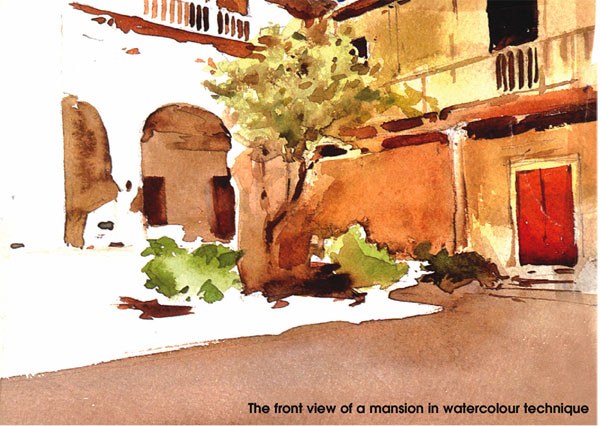|
Learn to draw by Tissa Hewavitarane
Painting houses and buildings
You cannot avoid houses and buildings if you are painting landscapes.
You must learn to make them look convincing and portray the texture of
the material such as bricks or thatched roofs, tiles and stone walls.
One of the most common faults with texture is over working. Some
amateur artists believe that it is necessary to indicate every brick on
the wall or to show every tile on the roof. They take hours
painstakingly and needlessly, painting row after row.

It is necessary to show details in small parts of the wall or roof
and viewers will fit in the rest themselves. They accept that without
thinking when looking at an object or a scenery when they start
painting.
Let us start with the basic construction be it a house, a temple,
cathedral or a tall building. You have to mentally strip it of all its
trappings, decorations, details and regard it in its simplest form.
Combine this thinking with the basic rules of perspective and you are in
business. Once you got these simple shapes looking right, you can start
adding details such as windows and doors. Once having got your basic
drawing done, next thing you have to think about the light and shade.
The usual fault is that not enough thought is given to lighting and
as a result the building looks flat and anaemic.
It seems fairly obvious that if you can see two sides of a building
one should be darker than the other lighter to give it solidity and
depth.
Using very dark areas on a house or a building would always make it
look dramatic. Remember the darker the shadow the brighter the adjacent
parts appear.
Do not neglect the use of smaller incidental shadows such as the
shadow under the gutter to show up the edge of the roof or under the
window openings to give depth. If the light at the time of painting is
not bright you can use your imagination and intensify the shadows, as
long as their direction is consistent.
An interesting and potentially lucrative sideline is house portraits
in watercolour. It is always fun and enjoyable to portray a countryside
residence with grand curved drive with lush green trees sweeping up to
the front entrance.
Notice the painting of a front view of this house.
The top of the tree is painted in several tones of green always on
the dry background. The tree trunk is painted with burnt amber. Railings
are defined by the darkness of the shadow behind them.
The back light means that light zones are clearly defined in two
areas; one completely white and the other where the shadows gives form
to the planes and darkness. The drawing paper used is Kent with a slight
grain and brushes Nos. 6, 8, 2 and 4 Sable hair. |

